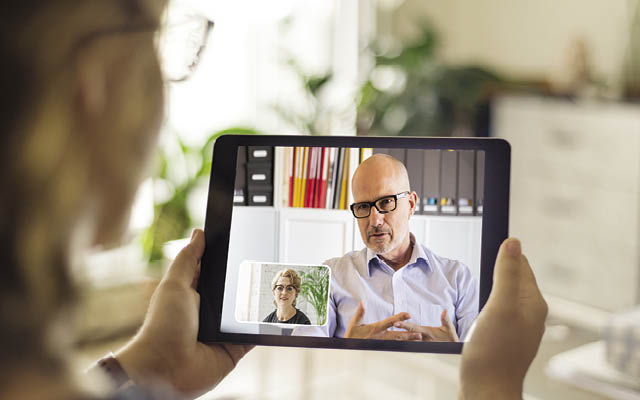Telehealth — consulting remotely with a doctor, a nurse, or a range of other healthcare providers through primarily digital platforms — is with us to stay. It was an option in many places before the pandemic, but COVID-19 spurred it to take off as home-quarantined patients met with practitioners, many of whom were sheltering in place themselves.
Today it’s become a well-established feature of American healthcare; according to a 2022 Census Bureau survey, more than 20 percent of Americans reported using telehealth services in the preceding four weeks.
Digital connections offer flexible scheduling options, in part because patients don’t have to travel to a clinic, which can benefit those living in remote areas. And telehealth is particularly convenient for the kind of support that’s not strictly medical, like nutrition advice and psychotherapy.
That said, telehealth can also create unique stresses, especially for newcomers to the practice. Which conditions are appropriate for telehealth, and which should always be handled in the clinic? Will patients be able to fully and clearly express their concerns when they’re communicating remotely? Will tech troubles degrade the care they receive?
Susan Blum, MD, MPH, a functional-medicine practitioner who regularly provides telehealth consultations, has some clear answers to these and related questions.
Stress Sources
- You’re not sure which health issues are best suited for a virtual visit. It can be hard to know whether a practitioner will be able to understand your symptoms and properly diagnose your condition if you’re not physically together in the room.
- You don’t know which healthcare practitioners you should see virtually. It may feel difficult to determine which doctors or specialists need you to come into the clinic for a physical examination and which ones don’t, as well as which providers are comfortable and experienced with providing telehealth.
- You’re concerned about the possibility of fraud. There are so many websites offering virtual health advice that it can be challenging to weed out scamsters from serious providers.
- You feel anxious about using telehealth technology. Attending a telehealth visit often requires basic knowledge of one or more digital conferencing and messaging platforms. And as everyone who has used digital devices for any length of time knows, tech is not always easy to navigate — and can fail from time to time.
- You don’t know how to best advocate for yourself over a video call. You may wonder whether you’ll be able to convey your health concerns adequately and get the clarity you need about diagnoses and treatments when you’re interacting with a small image on a screen.
- Anchor your telehealth activities with a regular provider. For Blum, the key to a good telehealth experience is to make sure you schedule your appointment with, or at least in partnership with, your regular healthcare provider. “Most of the time, your telehealth visit will be with a practitioner that you already have a relationship with,” she says.
- Get your provider’s advice about which conditions are best addressed by telehealth. “When you describe the situation to them on the phone or byportal message, they can help guide you,” Blum says.
The general rule of thumb is that a concern that requires a physical exam, like a serious fall, or conditions like heart problems, which may require checking vital signs, should be handled in the clinic. But in all cases, your main provider is your best guide.
Strategies for Success
1) Use telehealth for ongoing support. On the other hand, telehealth can be ideal for conducting follow-up visits to discuss how you’re feeling with your practitioner and to receive additional assistance and advice, Blum notes.
“In my world of integrative and functional medicine, I do so much coaching and teaching about lifestyle, nutrition, sleep, and the like. Video is a great way to do that,” she says. “The patient can check in regularly from home, and I can lend support. That wouldn’t happen if the patient had to come into the office every week.”
2) Get referrals for new practitioners. Your main in-person practitioner can also be your guide for providing referrals to other medical professionals, including specialists, and they’re likely to know which providers are experienced with telehealth.
When you’re considering a digital connection to, say, a certified nutritionist or an unlicensed consultant for whom you didn’t receive a professional referral, Blum warns against going it alone. Get a recommendation from a friend, family member, or colleague you trust.
3) Do your due diligence. If you’re worried that a professional may not be up to par, or might even be fraudulent, Blum suggests that you “do the same kind [of] careful check that you would do for somebody who has a bricks-and-mortar location. Do your research. Google them. Look at their credentials. Check for reviews online, on Yelp, or elsewhere. Ask them to connect you with one of their patients so you can check with that person about the practitioner.”
4) Get tech issues settled before the visit. Blum recommends taking plenty of time before the visit to familiarize yourself with the platform you’ll be using, getting whatever help you may need from the provider’s help desk or administrative professionals. “Then get on the call at least 10 or 15 minutes early,” she says. “Make sure your sound is working, make sure your video’s working, make sure you’re settled in place.”
If you have audio trouble with your digital platform, she adds, you can usually switch to a phone call for the audio component.
5) Make a list and bring it to the visit. Making the most of a telehealth visit calls for the same kind of preparation you need for an in-person consult, says Blum, which includes making a list of concerns. “Write down all your questions and have them ready,” she says. “Start the visit by asking the practitioner if you can go over the questions — don’t wait until the middle or the end. Then make sure that you get all of your questions answered as you go.”
6) Invite a trusted friend or family member along to the visit. One of the best ways to make sure that all of the information is successfully conveyed between patient and practitioner is to have a third party present at the appointment.
Share your list of questions with a trusted friend or family member and ask them to take notes during the appointment. Blum suggests then checking in with the individual at various points during the visit to be sure you haven’t missed anything along the way. After the visit, sit down together and go over the diagnosis and treatment plan provided by the practitioner to make sure you understand all the information you gathered.
Renewal
For more inspiration and strategies to overcome life’s challenges, please visit our Renewal department.
This article originally appeared as “Navigating Virtual Healthcare” in the September/October 2023 issue of Experience Life.





This Post Has 0 Comments